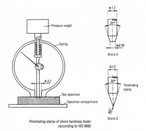Hardness
Polypedia > Properties of polymers > Physical properties
| Hardness shore | |
It is a property that anyone can notice simply by touching the rubber, but to determine exactly the level of hardness, specific instruments are needed as well as reference standards that will be described later. The softness or relative hardness of a material is often one of the first criteria considered when choosing a thermoplastic elastomer. Hardness is also related to other important design properties, such as the tensile and flexural modulus. Measurement of hardness The most common instrument to measure the hardness of rubber is called a Shore durometer. A spring is used to push a metal indenter into the surface of the material, measuring how far it penetrates. The instrument measures depth penetration from zero to 2.54 mm. A reading of zero on the scale means that the indenter is at maximum depth and a reading of 100 indicates no penetration was detected. Shore Durometers come in a variety of hardness ranges. One of the most common scales is the Shore A scale, which uses a blunt indenter and a moderate spring force. Shore A instruments are not as accurate when the readings are greater than 90. For harder materials, the Shore D durometer is used, as it has a sharp indentation and a stronger spring to penetrate to a greater depth. When even harder plastics are measured, instruments with sharper indenters and stronger forces are used, such as Rockwell hardness testers. At the other end of the scale, soft gels and soft foam rubbers are measured using the Shore 00 scale. Most materials will resist initial indentation, but will yield more over time due to creep or relaxation. The durometer readings can be taken instantaneously or after a specific delay time, which generally ranges from 5 to 10 seconds. An instant reading will always give a higher (or more difficult) reading than the delayed readings. The delayed readings are more representative not only of the hardness of the material, but also of the resistance. A weaker, less elastomeric material will drag more than a stronger and more resistant material. Accurate testing procedures are needed to guarantee valid data. To obtain an accurate reading, you must have a flat surface, as well as a sufficient part thickness to prevent the support surface from affecting the result. The usual required thickness is 0.200 inches, but hard TPEs that experience less deformation can be accurately measured at lower thicknesses. |   |
Relationship with other properties The hardness is often confused with other properties such as the flexural modulus. Although both properties reflect how the product feels in the client's hands, the flexure modulus measures the flexural strength, while the hardness measures the resistance to indentation. Within a specific TPE family, these two properties are related. Generally, as the hardness increases in value, so does the flexural modulus. The resistance to creep and tensile strength in a given TPE family are generally directly related. This means that a softer TPE will crawl more and have less tensile strength than a harder material. The coefficient of friction (COF) varies inversely with hardness. As the hardness of a TPE increases, the COF generally decreases. When comparing TPEs in different families, real physical property data beyond hardness is required to make appropriate material decisions. |  |
| Keywords | ||||||
abrasión | taber | martindale | EN ISO 20344 | ISO 4649 | EN 344 | DIN 53516 |
